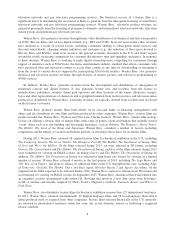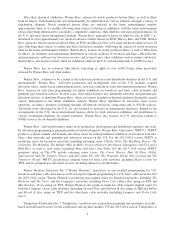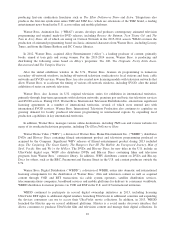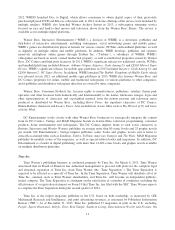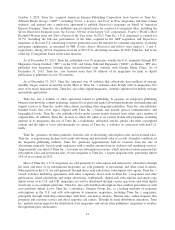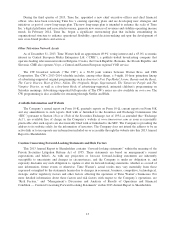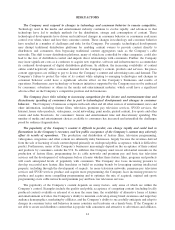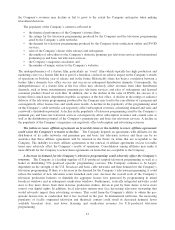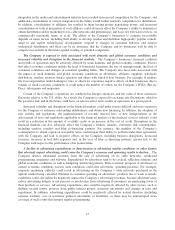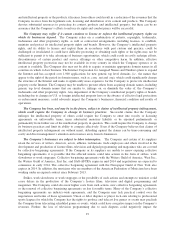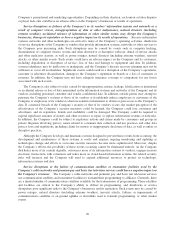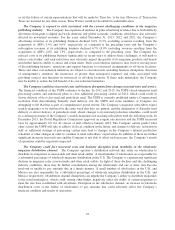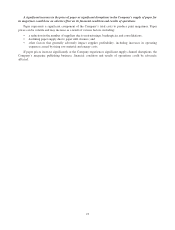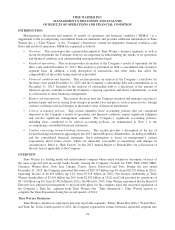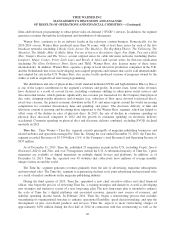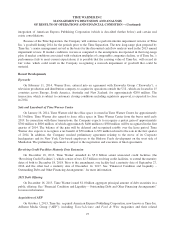Time Magazine 2013 Annual Report Download - page 33
Download and view the complete annual report
Please find page 33 of the 2013 Time Magazine annual report below. You can navigate through the pages in the report by either clicking on the pages listed below, or by using the keyword search tool below to find specific information within the annual report.integration in the media and entertainment industry have resulted in increased competition for the Company, and
additional consolidation or vertical integration in the future would further intensify competition for distribution.
In addition, consolidation of affiliates has resulted in them having greater negotiating power, and increased
consolidation or vertical integration of such affiliates could adversely affect the Company’s ability to maintain or
obtain distribution and/or marketing for its cable networks and premium pay and basic tier television services, on
commercially reasonable terms, or at all. The ability of the Company’s businesses to compete successfully
depends on many factors, including their ability to develop, market and distribute high-quality popular content,
adapt to and exploit technological developments, respond to changes in consumer behavior and achieve
widespread distribution, and there can be no assurance that the Company and its businesses will be able to
compete successfully in the future against existing or potential competitors.
The Company is exposed to risks associated with weak domestic and global economic conditions and
increased volatility and disruption in the financial markets. The Company’s businesses, financial condition
and results of operations may be adversely affected by weak domestic and global economic conditions. Factors
that affect economic conditions include the level of household formation, the rate of unemployment, the level of
consumer confidence and changes in consumer spending habits. The Company also faces risks associated with
the impact of weak domestic and global economic conditions on advertisers, affiliates, suppliers, wholesale
distributors, retailers, insurers, theater operators and others with which it does business. For example, if retailers
file for reorganization under bankruptcy laws or otherwise experience negative effects on their businesses due to
volatile or weak economic conditions, it could reduce the number of outlets for the Company’s DVDs, Blu-ray
Discs, videogames and magazines.
Certain of the Company’s operations are conducted in foreign currencies, and the value of these currencies
fluctuates relative to the U.S. dollar. As a result, the Company is exposed to exchange rate fluctuations, which in
the past have had, and in the future could have, an adverse effect on its results of operations in a given period.
Increased volatility and disruptions in the financial markets could make it more difficult and more expensive
for the Company to refinance outstanding indebtedness and obtain new financing. In addition, the adoption of
new statutes and regulations, the implementation of recently enacted laws or new interpretations or the
enforcement of laws and regulations applicable to the financial markets or the financial services industry could
result in a reduction in the amount of available credit or an increase in the cost of credit. Disruptions in the
financial markets can also adversely affect the Company’s lenders, insurers, customers and counterparties,
including vendors, retailers and film co-financing partners. For instance, the inability of the Company’s
counterparties to obtain capital on acceptable terms could impair their ability to perform under their agreements
with the Company and lead to negative effects on the Company, including business disruptions, decreased
revenues, increases in bad debt expenses and, in the case of film co-financing partners, greater risk to the
Company with respect to the performance of its feature films.
A decline in advertising expenditures or deterioration in advertising market conditions or other factors
that adversely impact advertising could cause the Company’s revenues and operating results to decline. The
Company derives substantial revenues from the sale of advertising on its cable networks, syndicated
programming, magazines and websites. Expenditures by advertisers tend to be cyclical, reflecting domestic and
global economic conditions, as well as budgeting and buying patterns. If the economic prospects of advertisers or
current economic conditions worsen, such conditions could alter advertisers’ spending priorities. For example,
corporate marketing cutbacks could result in advertising on the Company’s cable networks purchased in the
upfront market being cancelled. Declines in consumer spending on advertisers’ products due to weak economic
conditions could also indirectly negatively impact the Company’s advertising revenues, because advertisers may
reduce advertising budgets or not perceive as much value from advertising if consumers are purchasing fewer of
their products or services. Advertising expenditures also could be negatively affected by other factors, such as
shifting societal norms, pressure from public interest groups, economic uncertainty and changes in laws and
regulations. In addition, advertising expenditures could be negatively affected by natural disasters (including
extreme weather), acts of terrorism, political uncertainty or hostilities, as there may be uninterrupted news
coverage of such events that disrupts regular programming.
17



